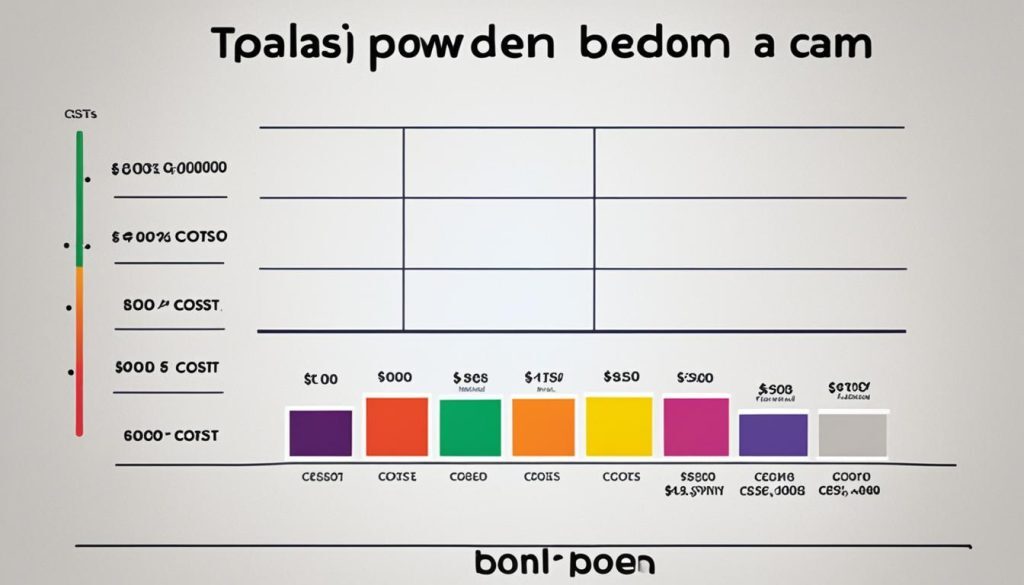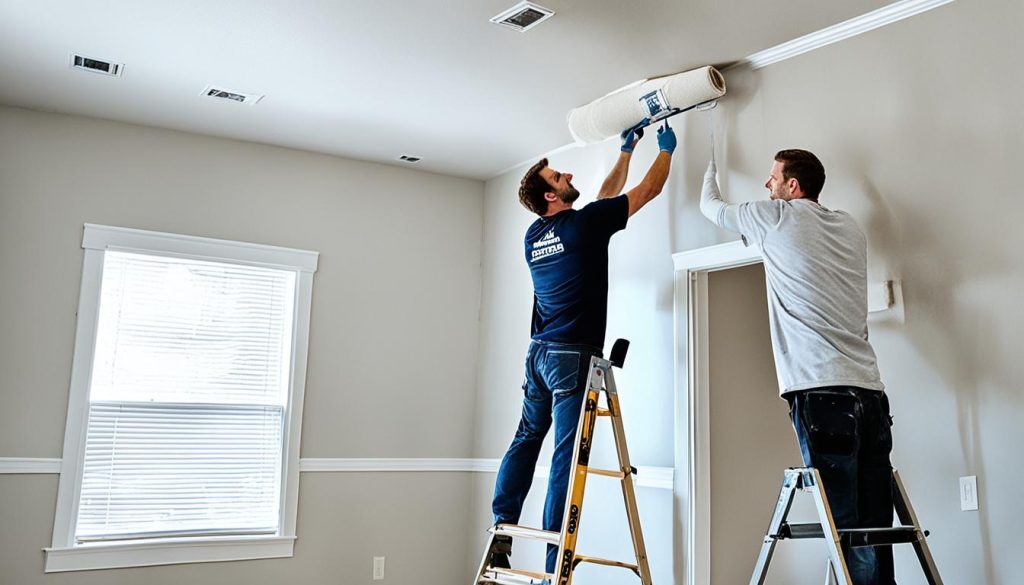Did you know that the average cost to paint the interior of a 2,000 square foot home in Canada can range from $4,000 to $4,500 for two coats on the walls? And that’s just the beginning!
When it comes to interior painting, the cost can vary greatly depending on various factors. Factors that can influence the cost include the size of the house, the level of prep work required, the location of the home, and the type of paint used.
To calculate an accurate price, professional painters follow a four-step process. They measure and count the areas that need painting, determine the time required based on production rates, multiply the hours by the company’s hourly rate, and add the cost of paint and materials.
But don’t worry! In this article, I will break down the factors that affect interior painting costs, provide a cost breakdown for painting different areas, highlight additional considerations you should keep in mind, and give you some valuable tips for saving on interior painting costs.
Key Takeaways:
- The average cost to paint the interior of a 2,000 square foot home in Canada is between $4,000 and $4,500.
- Factors that influence interior painting costs include the size of the house, level of prep work, location of the home, and type of paint used.
- Painting different areas within a home can vary in cost, with rooms, bathrooms, kitchens, and doors having their own price ranges.
- Additional considerations that affect interior painting costs include high ceilings, textured walls, trim painting, wall repairs, and furniture moving.
- You can save on interior painting costs by considering DIY options, hiring professional painters, and selecting cost-effective paint and finishes.
Factors That Affect Interior Painting Costs
When it comes to interior painting, there are several important factors to consider that can impact the overall cost of the project. Understanding these factors will help you estimate and plan for the expenses involved in painting the interior of your home.
- Size of the house: The size of the house plays a significant role in determining the cost of interior painting. Larger homes require more paint and labor, which can increase the overall cost. On the other hand, smaller homes may have lower costs due to the reduced amount of materials and time required.
- Level of prep work: The level of prep work needed before painting can also influence the cost. If your walls require repairs, such as patching holes or fixing damaged surfaces, it will add to the overall expenses. Similarly, if you need to move furniture or cover and protect certain areas, it can impact the labor involved and, consequently, the cost.
- Location of the home: The location of your home can have an impact on the pricing of painting services. Painting companies may charge different rates in different areas. Factors such as competition, cost of living, and regional market dynamics can all contribute to varying pricing structures. It’s worth considering this factor when estimating costs for your interior painting project.
- Type of paint used: The type of paint you choose for your interior walls can also affect the overall cost. Different brands and finishes of paint come at different price points. Higher-quality paints may be more expensive, but they often provide better coverage and durability. Consider your budget and desired paint quality when estimating the cost of your project.
By taking these factors into consideration, you can get a better understanding of the cost of your interior painting project. Remember, it’s always a good idea to consult with professional painters for accurate estimates based on your specific requirements.
| Factors | Impact on Cost |
|---|---|
| Size of the house | Higher square footage may lead to increased costs |
| Level of prep work | More repairs and furniture moving can add to the overall expenses |
| Location of the home | Pricing of painting services may vary based on the area |
| Type of paint used | Different paint brands and finishes come at varied price points |
The Impact of House Size on Cost
The size of your house is a crucial determinant of interior painting costs. Larger homes typically require more paint and labor, increasing the overall expenses. For instance, a 2,000 square foot home may have significantly lower costs than a 5,000 square foot home due to the difference in materials and time required.
Cost Breakdown of Painting Different Areas
The cost of painting different areas within a home can vary depending on various factors. Let’s take a look at the estimated costs for painting different areas:
Painting a Room
When painting an average-sized room, the cost can range from $280 to $420. The final price depends on the square footage of the room and the number of coats required for a seamless finish.
Painting a Bathroom
For bathrooms, powder rooms, and laundry rooms, the cost typically falls within the range of $280 to $420. The specific cost will depend on the size of the area and any additional preparation work needed.
Painting a Kitchen
Painting a kitchen can cost between $320 and $480. This estimate includes painting the walls and potentially additional costs for painting cabinets. The final price will depend on the size of the kitchen and any customization required.
Painting Doors
The cost of painting doors can range from $80 to $250. Factors influencing the price include the type of door and the level of detail required. Additional factors, such as the number of doors, should also be considered when estimating the cost.
These estimated costs provide a general idea of what to expect when painting different areas of your home. However, it’s important to note that the final cost may vary depending on additional factors such as the condition of the surfaces, the paint quality chosen, and any other customization or repair work required.

Additional Considerations for Interior Painting Costs
When calculating the cost of an interior painting project, there are several additional factors to consider. These factors can have an impact on the overall cost and should be taken into account to ensure an accurate estimate. Let’s explore some of the key considerations:
High Ceilings

Painting high ceilings can be a challenging task that requires special equipment and expertise. In order to reach and effectively paint high ceilings, painters may need to use scaffolding or tall ladders. This additional equipment and labor can increase the overall cost of the project. It’s important to consider this factor when estimating the cost to paint high ceilings.
Textured Walls
Textured walls can also impact the cost of an interior painting project. The texture on the walls can require additional paint and labor to achieve a smooth and even finish. The complexity of painting textured walls can add to the overall cost of the project. It’s essential to take into account the cost to paint textured walls when estimating the total expenses.
Painting Trim
Painting trim, including baseboards, door frames, and crown molding, is an additional consideration when estimating interior painting costs. The cost of painting trim can range from $1 to $3 per linear foot, depending on the complexity of the trim and the desired finish. Including the cost to paint trim in your estimate will provide a more accurate calculation of the overall project cost.
Wall Repairs
Before painting, it’s common to address any necessary wall repairs, such as patching holes or fixing cracks. These repairs may require additional labor and materials, which can impact the total cost of the project. It’s important to assess the extent of wall repairs needed and factor in the cost of materials and additional labor when estimating the overall painting cost.
Moving Furniture
When undertaking an interior painting project, it’s often necessary to move furniture out of the painting area. Moving furniture can be a time-consuming task that requires additional labor. Some painting companies may charge an extra fee for furniture relocation. It’s essential to consider the cost of moving furniture when estimating the total expenses of the project.
| Additional Considerations | Cost Impact |
|---|---|
| High Ceilings | Increased cost due to special equipment and labor |
| Textured Walls | Additional paint and labor required |
| Painting Trim | Range of $1 to $3 per linear foot |
| Wall Repairs | Additional labor and materials |
| Moving Furniture | Possible extra fee for furniture relocation |
Considering these additional factors will ensure a more accurate estimation of the cost for your interior painting project and help you budget accordingly.
Tips for Saving on Interior Painting Costs
When it comes to interior painting, there are several strategies you can implement to save on costs while still achieving beautiful results. Here are some useful tips:
If you have the skills and equipment, consider tackling the project yourself. DIY interior painting can significantly reduce labor costs. However, it’s important to ensure you have the necessary know-how and tools to achieve professional-looking results.
Hiring professional painters is another option worth considering. They possess the experience and expertise to deliver high-quality work efficiently. Although this option may require a higher upfront investment, their skill and efficiency can help you save in the long run.
When selecting paint and finishes, be mindful of cost-effective options that still provide the desired results. Research different brands and finishes, comparing prices to find the best value for money. Remember, selecting quality paint and finishes can contribute to a longer-lasting and more aesthetically pleasing paint job.
Obtaining multiple quotes from different painting companies is a recommended practice. This enables you to compare prices and services offered, ensuring you get the best deal possible. You may be surprised at the price variations among different painters, so take the opportunity to negotiate and find the most cost-effective option for your project.
